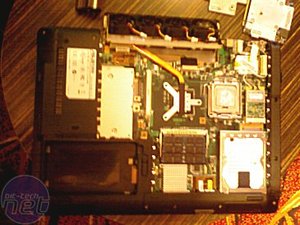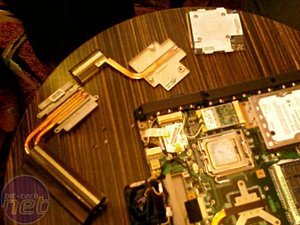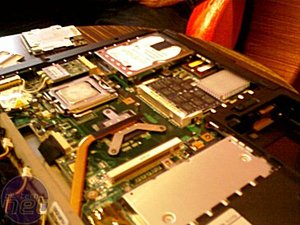DIY Notebooks
Asus also showed us one of its pet projects for the last few months – a DIY notebook. We’ve been hearing ATI and Nvidia talk about “upgradeable” notebooks ever since the MXM add-in mobile graphics card specification became a widely-adopted standard.Until now, we’ve rightly (or wrongly) taken the incredibly cynical stance of “we’ll believe it when we see it” whenever either company has talked about the prospects of upgradeable notebooks, but it looks as if we may well have been proven wrong.
The C90S is a strange cookie, and not just because you can upgrade it yourself with standard off-the-shelf components – we’ll come back to that in a minute. It’s the first notebook we’ve seen where you simply remove one panel to access almost all of the components inside the chassis. After removing a few screws, the guts of this beast are on show.
As if that wasn’t enough, Asus’s engineers then removed the CPU cooler and revealed not only an LGA775 socket, but also a regular Core 2 Duo E6600 processor. We inquired further about the notebook’s CPU support and it’s actually pretty incredible. Not only does the notebook support all current Core 2 Duo processors, it also supports Intel’s Core 2 Extreme X6800 – the company’s flagship dual-core processor.


Of course, Intel has moved on from dual-core processors at the top of its product stack, but this is a nevertheless impressive feat. Probably the only dampener on this feat is that the notebook doesn’t currently support those quad-core processors. Not only would it take a massive chunk of copper, it’d also need an uprated chipset, as the notebook’s i945 northbridge doesn’t support quad-core processors.
You’re probably thinking that the C90S will gulp up all of your battery power by the time you’ve said “gee that’s a powerful notebook”. You’d be wrong, but it’s not going to set the world on fire either. Asus reckons you’ll get around 90 minutes from this beast, but we’re not sure whether that’s with the screen set to a respectable brightness setting with wireless enabled. Probably not, but then I never expected this to come close to my ThinkPad.


The list of specifications continues with support for up to 3GB of DDR2 memory and Seagate’s latest 160GB 5400.3 hard drive. Given that the notebook is almost completely upgradeable, I’m sure you could choose a smaller (or larger, when available) hard drive if you wish. I guess that’s the beauty of a notebook that shares similar flexibility to a fully fledged desktop machine. We'll hopefully bring you some more details (and better pictures) over the course of the week, so stay tuned.

MSI MPG Velox 100R Chassis Review
October 14 2021 | 15:04









Want to comment? Please log in.